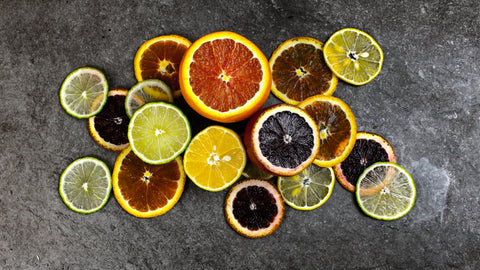Jake from Sharp and spring has officially sprung! While the pandemic continues and we've all been cooped up inside clearing out our dry storage and pantry we're nearing our first trips out of quarantine to brave the world and get ourselves to a grocery store. What a great time to stock up on fresh seasonal fruits and vegetables that we've all been missing. In this post I'm going to go over whats coming into season this spring and make a few suggestions of what you can prepare with them.
Apricot -
First off were taking a look at the apricots, peaches and nectarines less appreciated little brother. Apricots can get a bad rep from being bought out of season where peaches and nectarines seems to be a little better even off season. More popular in the mid-east their growing season in North America is as early April and through August, with the majority of our crops coming from California. Try them grilled and tossed in an arugula salad with some crumbled salty cheese like feta, cooked into a jam with warm spices like nutmeg clove, or just eaten fresh.

Artichoke -
Artichokes can be bought year round, either fresh or cleaned and canned. However, their peak season is between March and May. They can be used in countless dips either roasted or preserved, grilled for a salad, or used as a topping for a foccacia bread or pizza topping. Learn how to clean them and you may never go back to the canned ones again.

Arugula -
Arugula is one of the most popular greens used in north America and loved for their peppery, mild mustard flavor. Arugula likes a cooler temperature so the season runs from early spring and into early summer, and then again in the fall. Try it in a watermelon feta salad, on a cured meat sandwich,or even to replace basil in a pesto sauce.

Asparagus -
Asparagus is a personal favorite of mine, with the season running from Feb to June. Asparagus hardly needs any preparation at all, great to be served beside a grilled piece meat or fish it just needs a quick steam, grill, or saute. That said, asparagus can also be shaved thin to use in a salad, and we love to turn it into a pickle with a spicy chili garlic brine.

Avocados -
Hardly needing an introduction after the craze for avocados that's been going on for last few years, while being available year round they're available from October to march at their peak. Not just for your instagrammable toast, mash it into a super fresh guacamole or serve it with a lightly seared piece of tuna or other lean fish to add some richness to the dish.

Carrots -
Carrots are a staple in so many cuisines and used pretty much every where in the world. They prefer a sandy soil and a cooler climate. Meaning that the best harvests will be in early spring and during the fall. Whether you're making a mire poix, roasting them whole with some maple and chilies, or pickling them with daikon to make a bánh mì, stock up during a chilly time because they can last two to three months if stored dry in the fridge or a root cellar.

Chives -
Chives area favorite herb among cooks and gardeners alike. They grow like a weed and can take over a garden if you're not careful. With such a mild onion/garlic flavor even people that don't like garlic or onions can often enjoy chives. We use them from everything from omelettes, garnish for roasted meats, and in cream cheese for a bagel with lox.

Fava Beans -
Fava beans also known as broad beans can be used in place of edamame or peas. the season runs from late march to early may. Try them tossed into a butter and cheese pasta last minute, in a spring salad with hearty veg like asparagus and walnuts, or make ful, a middle eastern dish similar to hummus.
Fiddle heads -
Another favorite of mine is fiddle heads. Young ferns harvested before they uncurl and the leaves mature. Remember to always cook your fiddle heads as they are unsafe to eat raw. They have a very fresh, vegetal grassy flavor and my favorite way to prepare them is a quick saute in a pan with some garlic, shallots, and finished off with a squeeze of lemon or a splash of your favorite mild vinegar. Or try them in a salad or grilled with a steak.

Fennel -
Fennel is an ingredient I find a lot of home cooks and professionals alike don't know what to do with. With a sweet mild licorice flavor and a texture similar to a less fibrous celery it can be used in an infinite amount of ways. I love to roast it in a screaming hot oven and get a nice char on it, pureed into soups, or shaved thin to add a mildly sweet crunch to a salad. And don't throw out the fronds! They can be saved and used as a garnish with a texture similar to dill but a more concentrated fennel flavor.

Leeks -
Leeks are a larger, heartier spring onion. They prefer to cold so you can find them from late winter to late spring. Being much tougher than their scallion counter part they're great for roasting, braising, or grilling. Remember to always cut them down the center and clean them as they can get a little sandy inside. Try them in a potato and leek soup, braised with a tougher cut of meat, or my favorite,grilled and served with octopus.

Citrus-
It may be surprising that citrus fruits are in season during the coldest times of the year. From mid winter to early spring lemons, limes, oranges,and grapefruits are in full swing. Use them in salads, marinades, or just peel them for a snack. Don't throw away that zest though, anytime you use the juice you can add the zest to add more of the fruits fresh flavor without adding any more sometimes unnecessary acid.

Mangoes -
Depending on the variety of mango, they can be found in season from as early as February all the way through August. Cut them up and eat them as is, freeze them and throw them into your morning smoothing, or reach for the under ripe green mangoes for a more tart, firm Thai mango salad.
Morels -
Morels a spring time mushroom can be found from mid April to June in the great lakes area in southern Ontario. Morels are prized for their nutty flavor and meaty texture, frequently used in french cuisine and fine dining restaurants. A quick saute in butter is all these guys need. But you can also toss them into a brown butter sauce pasta with fresh peas, or cooked into a cream sauce to be served with your protein of choice. Remember not to eat them raw though, Morels must be cooked before fit for consumption.

Mint -
While available all year due to its popularity, being a hearty herb mint grows best after the last frost during early spring and is ready to harvest by late spring to summer. We love it in a garlicy yogurt sauce, in a chimmi churri for steak or muddled into a mojito.
Peas -
Hated by children world wide, loved by the culinary industry, especially in the UK. This spring time vegetable is in season between May through to the end of summer. Tossed into a pancetta and mushroom pasta last minute, thrown fresh into a salad, or pureed into a smooth minty puree to be served with grilled meat or classic UK fare.
Pineapples -
Pineapples grow best from April to May, and have more uses than just to be thrown into a smoothie. Try them roasted as a layer in coconut pineapple custard tart, use the juice as a marinade to break down tougher proteins,and I dare say, on a pizza? Oh yeah, we tried the thing where you just pull it apart. It didn't work.

Potatoes -
While potatoes are usually harvested in the fall and stored in a cellar for use throughout the rest of the year (Talk about shelf life!) they are usually planted in the early spring. Did you know that in order to harvest new potatoes it usually kills the plant? Which drives the price of new potatoes through the roof. Boil em, mash em, stick em in a stew. I mean, or you could roast them, fry them, or bake them.
Pro tip : Let your potatoes to acclimate to room temperature for two days before frying them. This brings the sugar levels in the potatoes down and allows you to get a crispier fried potato with a lighter colour!
Rhubarb -
The leaves of rhubarb are inedible,so this plant is grown for its tart, acidic stalks with a bright pink colour. Being so sour its usually used in desserts with enough sweetness to balance it out. I remember going out as a kid and seeing the rhubarb plants taller than me. We would cut the stalks down and dip them in sugar and eat them raw. Popularly seen in strawberry rhubarb pie, it can also be great poached or soaked in a syrup to be served with ice cream or panna cotta.
Ramps -
Possibly the king of seasonal spring vegetables, the humble ramp. A wild onion foraged between late April to early June. The popularity of the spring onions has "ramped" up in recent years. And as a slow growing crop we encourage you
to forage responsibly. Taking only 1/4 of the ramps that you find and instead of pulling them from the ground, instead cut into the ground leaving the bottom of the bulb intact to grow back. Alternatively you can harvest one of the two leaves
as they're every bit as delicious as the more sought after bulbs. Our favorite way to use ramps at the shop is to grill them quickly on a high heat and then put them into a sweet pickling liquid. Great with grilled meats and to contrast the nutty, meaty flavor of spring morels.

Watercress -
Watercress is a mild peppery green also known as nasturtium. It is a fast growing aquatic plant and can be eaten raw tossed into salads any way that you could use arugula,and contrary to the way that north Americans prepare the portugese soup caldo verde, watercress or collard greens are used traditionally instead of kale.
So that's a wrap folks! We've never had a better time to get ourselves back into the kitchen and away from take away and fast food. Remember keep your distance at the grocery store and only buy what you need to save some for everyone else. Stay safe, and as always, stay sharp.



